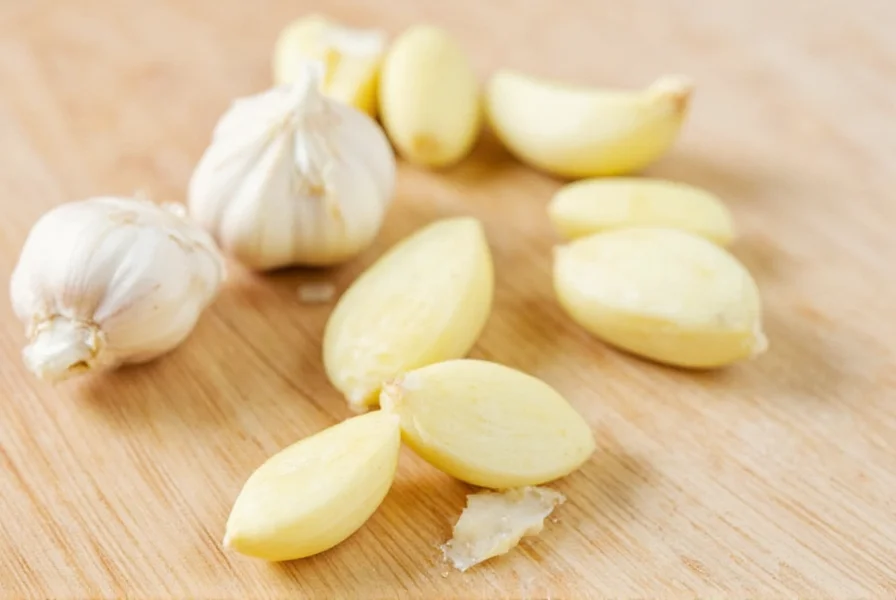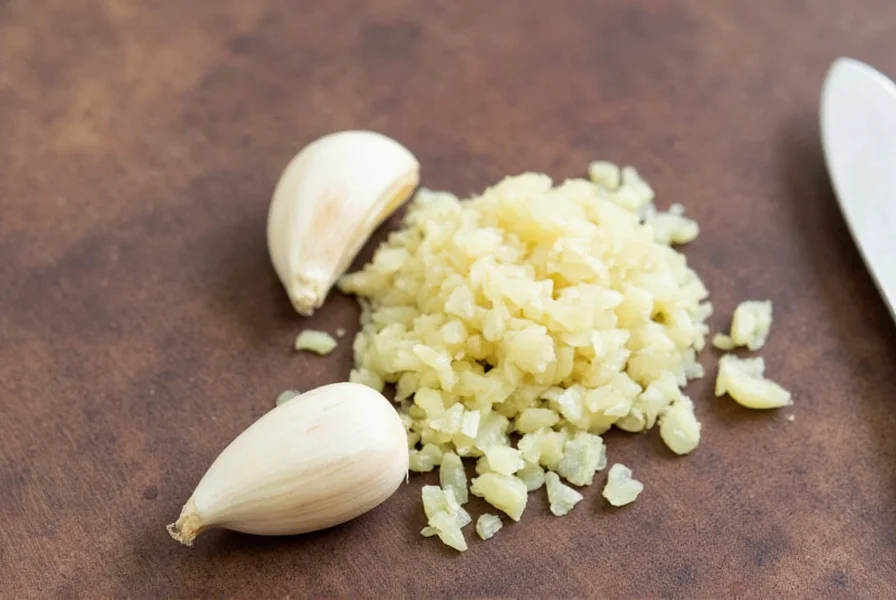Understanding garlic measurements is essential for recipe accuracy, especially when following instructions that specify "2 cloves of garlic minced." Getting this measurement right can significantly impact your dish's flavor profile without overwhelming it.
Garlic Clove to Volume Conversion Guide
Garlic measurements can be confusing when recipes switch between counting cloves and using volume measurements. Here's what you need to know about converting 2 cloves of garlic to minced form:
| Garlic Measurement | Volume Equivalent | Weight Equivalent |
|---|---|---|
| 1 small clove minced | ½ teaspoon | 3 grams |
| 1 medium clove minced | ⅔ teaspoon | 4-5 grams |
| 2 medium cloves minced | 1¾-2¼ teaspoons | 8-10 grams |
| 1 tablespoon minced | 3 cloves | 15 grams |
Factors That Affect Garlic Measurements
Several variables influence how much minced garlic you'll get from 2 cloves:
Clove Size Variations
Garlic cloves vary significantly in size. A single head of garlic contains both small inner cloves and larger outer cloves. When a recipe specifies "2 cloves," it typically assumes medium-sized cloves. If you're working with particularly large or small cloves, adjust accordingly:
- Small cloves: 2 cloves ≈ 1½ teaspoons minced
- Medium cloves: 2 cloves ≈ 2 teaspoons minced
- Large cloves: 2 cloves ≈ 2½ teaspoons minced
Mincing Technique Matters
Your mincing method affects the final volume. Finely minced garlic packed tightly into a measuring spoon yields more garlic by volume than loosely minced pieces. For the most accurate measurement of how much is 2 cloves of garlic minced, press the minced garlic into your measuring spoon to eliminate air pockets.

When Precision Matters in Garlic Measurement
While many home cooks simply eyeball garlic amounts, certain recipes require more precision for optimal results:
- Delicate sauces - Where garlic flavor should complement rather than dominate
- Raw applications - Such as salad dressings or aioli where raw garlic intensity is pronounced
- Preserving recipes - Where proper garlic-to-vegetable ratios affect safety
- Testing new recipes - When you need to understand exact flavor contributions
For most everyday cooking, the exact measurement of 2 cloves of garlic minced doesn't need to be perfect. However, understanding the standard conversion helps you adjust recipes confidently based on your garlic head's actual clove size.
Garlic Substitutions and Equivalents
When you don't have fresh garlic available or want consistent measurements, these substitutions work for the "how much is 2 cloves of garlic minced" question:
- Garlic powder: ¼ teaspoon replaces 1 clove, so 2 cloves = ½ teaspoon garlic powder
- Garlic salt: ½ teaspoon replaces 1 clove (contains salt, so reduce additional salt in recipe)
- Bottled minced garlic: 1 :1 ratio with fresh minced (check label as some contain preservatives)
- Garlic paste: ⅓ teaspoon replaces 1 clove of fresh garlic

Practical Tips for Measuring Garlic
Here are professional kitchen techniques for accurately measuring how much is 2 cloves of garlic minced:
- Peel and mince first: Measure after mincing, not before, as volume changes significantly
- Use a microplane: Creates consistently fine mince that packs evenly into measuring spoons
- Level off: Scrape excess with a knife edge for precise teaspoon measurements
- Consider flavor intensity: Older garlic heads often have stronger flavor, so you might use slightly less
- Smell test: If your kitchen fills with strong garlic aroma during mincing, you may want to reduce the amount slightly
Remember that garlic flavor intensifies as it sits after mincing. If preparing ingredients ahead of time, you might want to start with slightly less than the standard 2 cloves of garlic minced equivalent.
Understanding Recipe Garlic Measurements
Recipe developers face the same challenges you do when specifying garlic amounts. Professional recipes often include both clove counts and volume measurements to address the "how much is 2 cloves of garlic minced" question more precisely. When you see:
- "2 cloves garlic, minced" - Expect approximately 2 teaspoons
- "2 teaspoons minced garlic" - Use a measuring spoon for precision
- "1 small head garlic" - Typically contains 10-12 cloves totaling about 3 tablespoons minced
Understanding these conversions helps you adapt recipes based on what you have available while maintaining proper flavor balance. Whether you're wondering how much is 2 cloves of garlic minced for a pasta sauce or adjusting a soup recipe, knowing these measurements gives you cooking confidence.
How many tablespoons is 2 cloves of garlic minced?
Two cloves of garlic minced equals approximately 2/3 of a tablespoon (since 3 teaspoons = 1 tablespoon). This equals about 10 ml in metric measurement. The exact amount can vary between 1¾ to 2¼ teaspoons depending on clove size and mincing technique.
Does the size of garlic cloves significantly affect recipe outcomes?
Yes, clove size can significantly impact flavor intensity. A single large clove may contain as much garlic as three small cloves. For critical recipes, weighing minced garlic (8-10 grams for 2 medium cloves) provides more consistency than counting cloves. In most everyday cooking, however, the variation between medium-sized cloves won't dramatically alter your dish.
Can I use garlic powder instead of fresh minced garlic?
Yes, you can substitute garlic powder for fresh minced garlic using a 3:1 ratio by volume. For 2 cloves of garlic minced (approximately 2 teaspoons), use ½ teaspoon of garlic powder. Remember that garlic powder has a different flavor profile - it's more concentrated and lacks the fresh, sharp bite of raw garlic, so you may need to adjust other seasonings accordingly.
Why does my recipe call for minced garlic instead of chopped?
Minced garlic has a much finer texture than chopped garlic, which affects both flavor distribution and intensity. Minced garlic releases more allicin (the compound responsible for garlic's flavor) and distributes more evenly throughout a dish. For 2 cloves of garlic minced, the finer cut means the garlic flavor permeates the entire dish rather than creating concentrated pockets of flavor that larger chopped pieces would provide.
How can I prevent garlic from burning when cooking?
Garlic burns easily due to its low water content. To prevent burning when using the equivalent of 2 cloves of garlic minced: 1) Cook over medium-low heat rather than high heat, 2) Add garlic after other aromatics like onions have softened, 3) Stir constantly while cooking, 4) Consider adding a small amount of liquid to the pan to regulate temperature, or 5) Mix minced garlic with a tablespoon of oil before adding to the pan to create a more controlled cooking environment.










 浙公网安备
33010002000092号
浙公网安备
33010002000092号 浙B2-20120091-4
浙B2-20120091-4